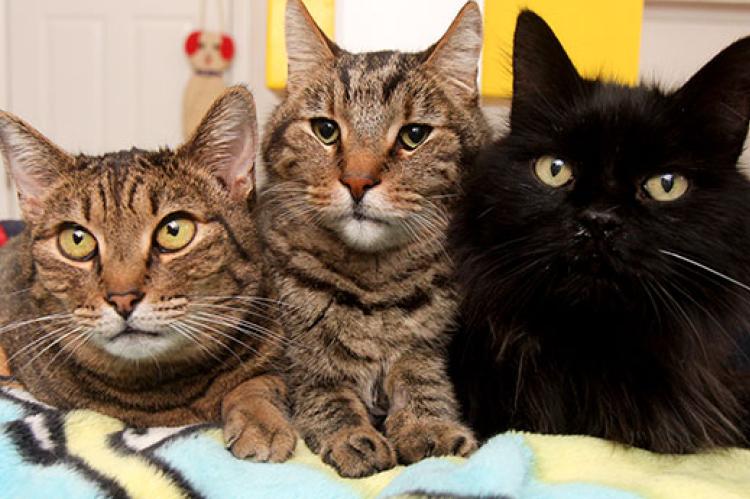Humane Outdoor Cat Deterrents

Free-roaming and feral cats (or community cats as we like to call them) live in our communities and make their homes wherever they can find food and shelter. While some people in the community may help care for these cats, others can legitimately feel that the cats are a nuisance because they eliminate in their gardens, yowl at night, or spray smelly urine.
However, removing the cats won't solve the problem as more cats will usually move in. Fortunately, there are ways to protect both the cats' lives and people's property using humane outdoor cat deterrents. The solutions don't happen overnight, though, so each party needs to be patient, compromise, and work toward the end goal of reducing the number of cats.
Trap-neuter-vaccinate-return (TNVR)
Whether you love or loathe community cats, trap-neuter-vaccinate-return (TNVR) is the most effective and humane way to effectively reduce the number of community cats and also reduce nuisance behaviors.
In a TNVR program, cats are humanely trapped, spayed or neutered, vaccinated, and then returned to their communities to live out their lives. Because they have been fixed and can no longer breed, the number of cats is reduced over time.
Being spayed or neutered also stops nuisance behaviors. Male cats are no longer competing or fighting with each other, spraying urine, or roaming blocks away from their neighborhood. Female cats no longer yowl to seek a mate and no longer have kittens, of course.
These behaviors are typically reduced immediately and eliminated completely only a month after the surgery. Additionally, TNVR provides vaccines, so the cats are healthier and do not pose a threat to public health.
Humane outdoor cat deterrents
The following are options for humane outdoor cat deterrents:
- Motion-activated sprinklers: Motion-activated sprinklers have an infrared sensor that releases a short blast of water. The sprinklers can “fire” up to 1,000 times on one nine-volt battery and typically cover an area 35 by 45 feet. These devices can be purchased through online retailers.
- Ultrasonic deterrents: This type of deterrent uses a motion sensor and emits a high-pitched ultrasonic alarm that can’t be heard by humans but will frighten most cats and (in some cases) small dogs. You place the unit facing the area you want to protect. Some versions use nine-volt batteries, while others are solar-powered. These devices also can be purchased through online retailers.
- Scat mats: These harmless mats or carpet runners are made of flexible plastic spikes. Place on the ground with spike side up to discourage cats from digging.
- Other digging deterrents: Push chopsticks into small potted plants. Use pinecones, lava rocks, concrete pavers, or stones as mulch to prevent cats from digging. Place large river rocks throughout the garden, or use poultry fencing or landscape wrap around plants.
- Smells that repel cats: To keep cats out of yards or gardens, plant the herb rue or sprinkle dried rue. Citrus or lemon scents, garlic, ammonia, vinegar, coffee grounds, pipe tobacco, mustard, citronella, or eucalyptus all deter cats as well. The scents diminish over time, so reapplying is necessary.
- Neutralizing urine smell: OdoBan, Nature’s Miracle, Fizzion, and Simple Solution are effective natural enzyme products that are available at pet supply stores or online.
- Blocking off access: Cats seek out dry, warm shelter away from the elements. Block off access to the places in which you don’t want cats (making sure no cats are inside before doing so). To guide cats away from those areas, provide another shelter. There are many inexpensive options for community cat shelters.
Additional tips for community cat caregivers
Here are some more tips to help community cats be good neighbors:
- Keep the feeding station neat and tidy. Remove all trash and leftover food promptly.
- Feed the cats at a regular place and time during daylight hours, and only feed enough to last one feeding. This practice not only will help the cats get on a schedule, but it also will eliminate attracting other wildlife.
- Establish a litter box. Creating a sandy area that you clean regularly will help keep the cats from eliminating in areas where you don’t want them to eliminate.
- Plant a bed of catnip in an area where you don’t mind the cats hanging out. They’ll be drawn to the catnip instead of the flowerbeds.
- Provide a shelter so the cats are not nesting in places where they are not wanted. There are many options available; search online for feral cat shelters, including DIY options.
- Know your local laws and ordinances. Protect yourself and the cats by knowing your legal rights.
- Educate your neighbors and keep an ongoing dialog with them. Make sure the outdoor cat deterrents or solutions are implemented and are working for them.
- Ensure that the cats you are caring for have been through TNVR, including any new cats who show up. Keep accurate records on how many cats you care for.